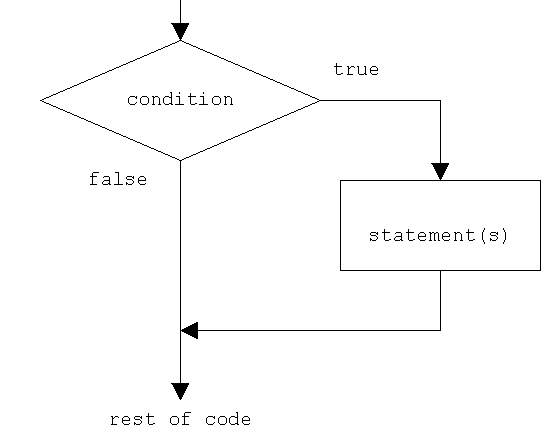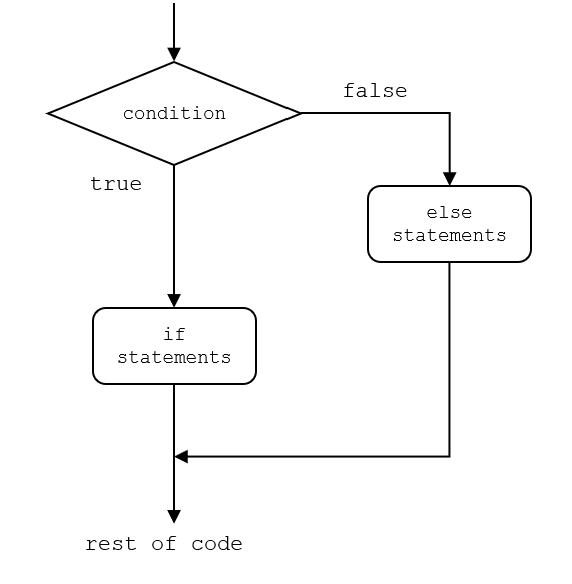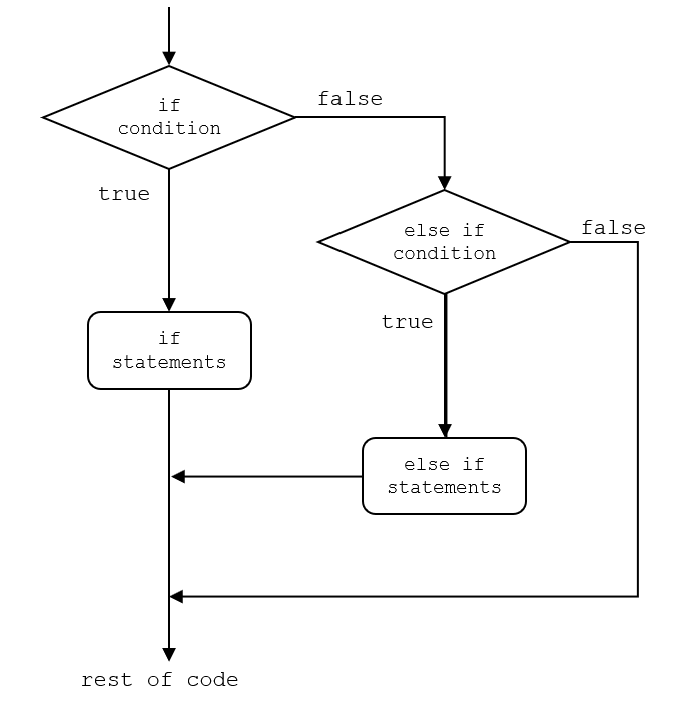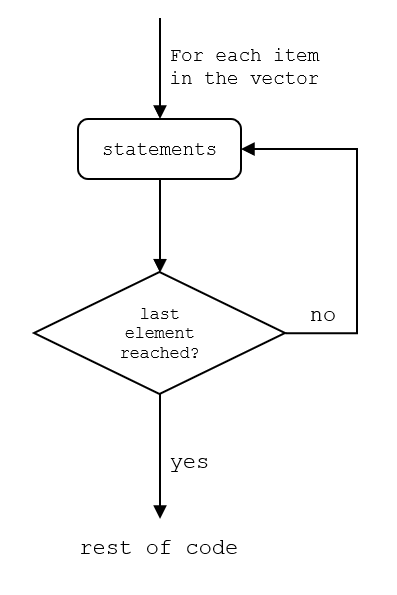If Statements, Loops, and Custom Functions
Tips before you start:
-
You might want to start a new .Rmd file for this activity
-
Throughout this workshop, instead of typing in commands directly in the command line or in the code editor, type them in chunks of code in your .Rmd file.
This sections covers some intermediate coding skills that you can use to make your code more efficient: ifs, for loops, and custom functions.
If statements and loops help implement logical operations in any programming language. A function groups operations into a single line of code which can be used repeatedly with different inputs. We will learn how to write these operations in R through basic examples.
If Statements
An if statement in R has the following syntax:
if (<condition>) {
<statement1>
<statement2>
...
<statementX>
}

If the condition is True, then the statements inside {} are executed. If the condition is False, the statements are ignored and nothing happens. Try running this block of code which will print out a message if x is smaller than 10:
# Create an object called x with the value of 5
x <- 5
# If x is smaller then 10
if (x < 10) {
# Print the sentence "x is smaller than 10
print("x is smaller than 10!")
}
## [1] "x is smaller than 10!"
⭐ Task 4-1
Use an if statement
Change the condition in the if statement above so that when you run the code, nothing is printed.
Check your code
# If x is larger then 10
if (x > 10) {
# Print the sentence "x is smaller than 10
print("x is smaller than 10!")
}
We can also edit the if statements to include an else clause to execute another statement if the condition is False. For example:
# Change x to the value of 10
x <- 10
# If-else statement
if (x < 10) { # If x is smaller than 10
print("x is smaller than 10!") # print that x is smaller than 5
} else { # if x is NOT smaller than 10
print("x is larger than or equal to 10!") # print that x is larger or equal to 10
}
## [1] "x is larger than or equal to 10!"

How about checking more conditions? Use else if! else if will create a new if statement after the original if else, as shown in the figure below:

You can create as many new chains of if and if else a you want! For example, any guesses which message the code will print out?
x <- 12
if (x < 5) {
print("small x")
} else if (x < 10) {
print("medium x")
} else if (x < 15) {
print("large x")
} else {
print("very large x")
}
⭐ Task 4-3
Create an else if chain of statements
Change a chain of if and else if statements that print the letter grade (i.e., print("the grade is A") for percentage scores according to Uvic’s Grading Standards. You can have the percentage score in a object called score, which will receive a value from 0 to 100.
Check your code
# Just a random score value between 0 and 100
score <- 75
if (score < 50) { # if the score is smaller than 50
print("the grade is F") # print the grade is F
} else if (score < 60) { # if not smaller than 50 and smaller than 60
print("the grade is D") # print the grade is D
} else if (score < 70) { # if not smaller than 60 and smaller than 70
print("the grade is C") # print the grade is C
} else if (score < 80) { # if not smaller than 70 and smaller than 80
print("the grade is B") # print the grade is B
} else { # if not any of the above
print("the grade is A") # print the grade is A
}
## [1] "the grade is B"
Loops
A for loop runs the same lines of code for a set of values in a vector. For example, imagine you have a vector of percentage scores of students (we can use the same one from Activity 2), and we want to assign them a letter grade for each of these values. That means, you want to apply the if and if else chain that you just created in the section above to each of the values of scores in your vector. This is where a for loop comes in handy.
The syntax of for loops is the following:
for (i in <vector>) {
<statement1>
<statement2>
...
<statementX>
}

What the for loop does is subsequentially run the statements for each item in the vector, until the last item is reached, at which point the for loop stops.
For example, using the scores from Activity 2, you could add the if and else if chain inside the for loop, and it will print the letter grade for each value of the vector.
# Create the vector of scores
score <- c(75, 91, 68, 83, 66, 94, 85, 86, 75, 80)
# Run the for-loop for each score in the vector
for (i in score) { # this sets each item of the vector score to i, starting with the first item, and so on
if (i < 50) { # if i (i.e. the item from the vector score) is smaller than 50...
print("the grade is F") # print the letter grade...
} else if (i < 60) { # and so on
print("the grade is D")
} else if (i < 70) {
print("the grade is C")
} else if (i < 80) {
print("the grade is B")
} else {
print("the grade is A")
}
}
## [1] "the grade is B"
## [1] "the grade is A"
## [1] "the grade is C"
## [1] "the grade is A"
## [1] "the grade is C"
## [1] "the grade is A"
## [1] "the grade is A"
## [1] "the grade is A"
## [1] "the grade is B"
## [1] "the grade is A"
Note that, inside the for loop, the values of the vector are called by i (and not the vector name). You defined this i object in the for loop call, by saying for(i in score). This is a temporary object created inside the for loop, and that takes the value of each item in the vector each time the statements are run. You don’t have to call this i, you could call it however you like, as long as it follows R’s rules for naming objects.
Another very important point in learning how to use for loops is knowing how to save results of a for loop in an appropriate way. The best way to do this is to create an object outside the for loop where you will save the results of each iteration of the loop. For that, is it useful to have i be a sequence of numbers for locations in vectors, so that you can call in certain locations from a vector, and then save in the same location in another vector.
Here’s an example for the scores:
# Create the vector of scores
score <- c(75, 91, 68, 83, 66, 94, 85, 86, 75, 80)
# Create a vector where letter grades will be saved. The vector contains NA values, with the same length of the score vector
grades <- rep(NA, times = length(score))
# Note that here, before running the for loop, the vector of grades is made only of NA values
grades
## [1] NA NA NA NA NA NA NA NA NA NA
# Run the for-loop for each score in the vector. Now, instead of running for each value of the
# vector "score", we will run the for loop for a vector of numbers, from 1 until the length of the vector scores
for (i in 1:length(score)) {
# instead of calling i inside the if condition, we are indexin the vector "score" by the number in i
if (score[i] < 50) { # score[i] meand the ith position in the vector "score"
grades[i] <- "F" # Instead of printing the grade, we now assign the grade to the ith location on the vector "grades"
} else if (score[i] < 60) { # and so on
grades[i] <- "D"
} else if (score[i] < 70) {
grades[i] <- "C"
} else if (score[i] < 80) {
grades[i] <- "B"
} else {
grades[i] <- "A"
}
}
# Now if you look at the vector "grades", the letter grades are saved in the vector
grades
## [1] "B" "A" "C" "A" "C" "A" "A" "A" "B" "A"
⭐ Task 4-3
Create a for loop
Imagine you want to compare each score to the average score and save whether each score was above or below average. Create a for loop that saves in an object called comparison a sentence stating whether the score was below or above/equal to average for each of the scores.
Hint: you can use a single if else statement inside the for loop for this.
Check your code
# Create the vector of scores
score <- c(75, 91, 68, 83, 66, 94, 85, 86, 75, 80)
# Create object to save results
comparison <- rep(NA, times = length(score))
for (i in 1:length(score)) { # For a vector of numbers, from 1 until the length of the vector scores
if(score[i] < mean(score)) { # If the ith score value is smaller than the average value
comparison[i] <- "score below average" # save "score below average" in the results
} else { # if not
comparison[i] <- "score above or equal to average" # save "score above or equal to average" in the restul
}
}
# See results
comparison
## [1] "score below average" "score above or equal to average"
## [3] "score below average" "score above or equal to average"
## [5] "score below average" "score above or equal to average"
## [7] "score above or equal to average" "score above or equal to average"
## [9] "score below average" "score below average"
Custom Functions
We’ve used many functions built into R and from installed packages but what if there is no off-the-shelf function that does exactly what we want or deals with our specific dataset? Let’s take matters in our own hands and build a function ourselves!
Defining a function in R follows the syntax:
function_name <- function(input1, input2, ...) {
<statement1>
<statement2>
do something with the inputs
return(<result>)
}
A function usually takes in a number of inputs (also called arguments), performs some operations with the inputs, and return a result. All the objects and operations performed within the function will be temporary, and when the function finishes performing the operations, it will only return what you ask it to return through the return() command.
For example, let’s start with a very simple function so you understand how it works. Even though R has a built in mean() function, you can create that yourself:
new_mean <- function(vector) { # creates a function called "new_mean", which has one argument called "vector"
sum_values = sum(vector) # The function first sum the values in vector
n_values = length(vector) # the it gets the number of values in the vector.
mean_value = sum_values / n_values # then it calculates the mean by dividing the sum by the number of values
return(mean_value) # Finally, the function returns the mean_value as the result
}
Running the lines above in R doesn’t do anything yet other than defining the function. To run the function (for example, to get the mean value of the student scores), you then have to call the function:
new_mean(vector = score)
## [1] 80.3
Note that none of the objects created inside the function were actually created in your workspace. If you want to save the result in an object in your workspace:
# Run the function to calculate the mean and save it in the object score_mean
score_mean <- new_mean(vector = score)
# See the resut
score_mean
## [1] 80.3
# Check if it's the same as R built-in function
mean(score)
## [1] 80.3
So now you know how functions work in R. Functions are really useful when you are repeating the same task over and over it. For example, imagine you are an instructor who wants to easily and quickly transform your student’s percentage scores to letter grades. Instead of writing that long if else if chain of commands every time, you could build a function that does it for you. Here’s how you could do it:
# Create function get_grades that transforms percentage scores into letter grades
get_grades <- function(percentages) { # the function has one argument called percentages
# Create a vector where letter grades will be saved. The vector contains NA values, with the same length of the percentages vector
grades <- rep(NA, times = length(percentages))
# Run the for-loop for each value in the percentages vector, to get the letter grade, as done above. This is the same for loop as above,
# only substituting the "score" vector by the function argument 'percentages"
for (i in 1:length(percentages)) {
if (percentages[i] < 50) { # percentages[i] means the ith position in the vector percentages
grades[i] <- "F" # Instead of printing the grade, we now assign the grade to the ith location on the vector "grades"
} else if (percentages[i] < 60) { # and so on
grades[i] <- "D"
} else if (percentages[i] < 70) {
grades[i] <- "C"
} else if (percentages[i] < 80) {
grades[i] <- "B"
} else {
grades[i] <- "A"
}
}
# return the vector grades as a result
return(grades)
}
Now you can use the function to get letter grades for any vector of scores
# Create the vector of scores
score <- c(75, 91, 68, 83, 66, 94, 85, 86, 75, 80)
# Get letter grades
grades <- get_grades(percentages = score) # this says that the vector called "score" will serve as the argument called "percentages" in the function
# See the grades
grades
## [1] "B" "A" "C" "A" "C" "A" "A" "A" "B" "A"
⭐ Task 4-4
Let’s make it a challenge
Fancy adding another if statement to it? Try modifying the get_grades function to print out a warning when someone’s score is above 100 and if that happens, assign the score to the maximum value of 100. Feel free to ask the instructor for help!
Hint: you can add a single if statement right at the start of the for loop!
Check your code
# Create function get_grades that transforms percentage scores into letter grades, and also
# corrects scores larger than 100
get_grades <- function(percentages) { # the function has one argument called percentages
# Create a vector where letter grades will be saved. The vector contains NA values, with the same length of the percentages vector
grades <- rep(NA, times = length(percentages))
# Run the for-loop for each score in the vector, to get the letter grade, as done above
for (i in 1:length(percentages)) {
# First, check if the value is larger than 100
if(percentages[i] > 100) {
# Print a warning
print("Value larger than 100 identified, substituting by 100")
# Substitute the value for 100
percentages[i] <- 100
}
# Now assigns the letter grades
if (percentages[i] < 50) { # percentages[i] mean the ith position in the vector "percentages"
grades[i] <- "F" # Instead of printing the grade, we now assign the grade to the ith location on the vector "grades"
} else if (percentages[i] < 60) { # and so on
grades[i] <- "D"
} else if (percentages[i] < 70) {
grades[i] <- "C"
} else if (percentages[i] < 80) {
grades[i] <- "B"
} else {
grades[i] <- "A"
}
}
# return the vector grades as a result
return(grades)
}
# Test the function
# Create the vector of scores, with values larger than 100
score <- c(75, 91, 68, 83, 120, 94, 85, 86, 75, 80)
# Get letter grades
grades <- get_grades(percentages = score)
## [1] "Value larger than 100 identified, substituting by 100"
# See the grades
grades
## [1] "B" "A" "C" "A" "A" "A" "A" "A" "B" "A"